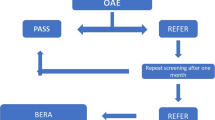Abstract
Significant hearing loss is one of the most common major abnormalities present at birth. If undetected, it will impede speech, language and cognitive development. Significant bilateral hearing loss is present in 1 to 3 per 1000 new born infants in the well-baby nursery population and in 2 to 4 per 100 infants in the intensive care unit population. It is an established fact that if hearing loss is present it should be detected and remediated before the baby is 6 months old. Neither universal screening nor a high risk screening, exists in majority of the hospitals in our country. In such a situation, a centralized facility catering to all hospitals in the city is a practical option. A two-stage screening protocol is projected, in which infants are screened first with otoacoustic emissions (OAE). Infants who fail the OAE are screened with auditory brainstem response (ABR). This two tier screening program (the second tier being ABR, which is more expensive) is required only for a selected few, making the program more practical and viable. It is the practicability of this program that makes it relevant for replication in other cities of the country, making it a model screening program for any developing country.
Similar content being viewed by others
References
Yoshinaga-Itano C, Apuzzo ML. Identification of hearing loss after age 18 months is not early enough. Am Ann Deaf. 1998;143:380–387.
Yoshinaga-Itano C, Apuzzo ML. The development of deaf and hard of hearing children identified early enough through the high risk registry. Am Ann Deaf. 1998;143:416–424.
Fortnum HM, Summerfield. AQ, Marshal DH, Davis A, Bamford M. Prevalence of permanent childhood hearing impairment in United Kingdom and implications for universal neonatal hearing screening: Questionare based assertainment study BMJ. 2001;323:536–540.
Ruben RJ. Effectiveness and efficacy of early detection of hearing impairment in children. Acta Otolaryngol. 1991;482:127–131.
Erenberg A, Lemons J, Sia C, Tunkel D, Ziring P. Newborn and infant hearing loss: detection and intervention. American Academy of Pediatrics. Task Force on Newborn and Infant Hearing. 1998–1999. Pediatrics. 1999;103:527–530.
Yoshinaga-Itono C. Efficacy of early identification and early intervention. Semin Hear. 1995;16:115–123.
Camey AE, Moeller MP. Treatment efficacy: hearing loss in children. J Speech Lang Hear Res. 1998;41:S 61–S 84.
Beatriz CWR. Parents of deaf children. In: Prabakar E, Claudia K, Sian T. Listening to Sounds and Signs: Trends in Deaf Education and Communication. 1st ed. Bangalore: Christoffel Blinden Mission and Books for Change 1988.p.14.
Report of the Collective Study on Prevalence and Etiology of Hearing Impairment. New Delhi: ICMR and Department of Science; 1983.
Kacker SK. The scope of pediatric audiology in India. In: Deka RC, Kacker SK, Vijayalakshmi B, eds. Pediatric Audiology in India, 1st ed. New Delhi: Otorhinolaryngological Research Society of AIIMS; 1997. p.20.
Nagapoornima P, Ramesh A, Srilakshmi, Rao S, Patricia PL, Gore M. Universal hearing screening. Indian J Pediatr. 2007;74:545–548.
Vaid N, Shanbag J, Nikam R, Biswas A. Neonatal hearing screening — The Indian experience. Cochlear Implants Int. 2009;10, 111–114.
Joint Committee on Infant Hearing; American Academy of Audiology; American Academy of Pediatrics; American Speech-Language-Hearing Association; Directors of Speech and Hearing Programmes in State Health and Welfare Agencies. Year 2000 Position Statement: Principles and guidelines for early hearing detection and intervention programmes. Pediatrics. 2000;106;798–817.
Author information
Authors and Affiliations
Corresponding author
Rights and permissions
About this article
Cite this article
Paul, A.K. Early identification of hearing loss and centralized newborn hearing screening facility-the Cochin experience. Indian Pediatr 48, 355–359 (2011). https://doi.org/10.1007/s13312-011-0067-0
Published:
Issue Date:
DOI: https://doi.org/10.1007/s13312-011-0067-0




